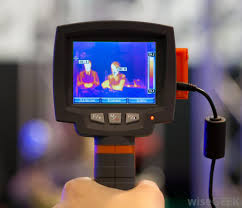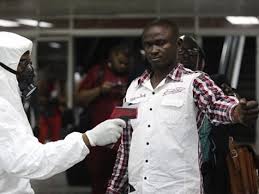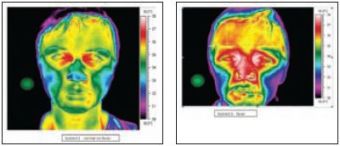A Center for Disease Control advisory states “People who have been exposed to Ebola should not travel on commercial airlines until there is a period of monitoring for symptoms of illness lasting 21 days after exposure. “This has presented a conundrum for officials in West Africa, especially airport security workers. How to determine symptoms in passengers who are in their presence for but a few moments? One solution they’ve been employing is to take temperatures, a time-consuming practice.

Might using thermal Imaging cameras speed up the process?
Since one of the symptoms of Ebola is a temperature of 101.5 or more, temperature-taking has emerged as a daily routine in some countries. You know those signs posted in US bathrooms reminding employees to wash their hands ? They’re nothing compared to Liberia’s Ebola-fighting hygiene requirements.
Hygiene and Health Surveillance
Nicole Beemsterboer, a NPR producer, just back from ten days in Liberia, reports in her blog , Goats and Soda, that there are buckets of chlorine everywhere, and before granting admittance to any government buildings, officials watch employees and visitors wash their hands. Then they take each person’s temperature with an ear-gun thermometer. The temperature is then written or printed on an ID tag and attached to the person’s clothing where it will be visible to all inside (who are also wearing tags).
Anyone with a temperature is sent to a medical facility for further screening.
One can only imagine the long queues forming each morning as employees arrive for work. But that’s nothing compared to the lines at airports. As if clearing customs didn’t take enough time, passengers departing from many West African airports also have to have their temperatures taken with an ear-gun.

When Beemsterboer ‘s plane landed in Casablanca from Liberia, the passengers underwent a different type of screening.
In an effort to both speed up the process , and provide officials with a bit more distance from potentially Ebola-infected passengers, many airports are turning to thermal imaging cameras.
Thermal Imaging Cameras as Homeland Security
Reuters also reports that several Asian countries are employing thermal imaging screening as a pre-boarding requisite , as well as at major entry points along their borders.
SInce everything whether animate, or inanimate, gives off heat in the form of energy waves, thermal imaging sensors have long been used to measure the intensity of the waves. Military applications like night goggles, heat-seeking sensors, and cameras have long been a wartime staple. And now, thermal imaging cameras are perched on a new threshold of possibility.
Since the human body is constantly radiating thermal energy the cameras’ sensors are able to collect and convert it into temperature measurement. Thermal imaging cameras and sensors portray temperature on a progressive rainbow palette, with cold at the purple, blue, green end, and hot at the yellow,orange, red end.
When detecting temperature in humans, exposed skin of the arms and face will always show up warmer. The warmest area is the area surrounding the tear ducts, the coolest area is the nose, since it is the cooling mechanism for the air we breathe as it enters the body. It is usually seen as blue or green. However should a person be running a fever, there will be a higher proportion of reds in the thermal image and perhaps a few white areas.

The image on the left is of a healthy individual, on the right is an individual running a fever.
An elevated temperature can be caused by any illness or inflammation, so using thermal cameras is far from a solution to detecting Ebola.
But they can be a tool for filtering out people travelling while ill, and will allow security officials to remove the individual from the boarding line and put him/her into isolation until a blood test, which is the only definitive test for Ebola, can be administered.
Should you want information about thermal imaging IP cameras for surveillance purposes or any other type of IP camera system, Contact Kintronics at 914-944-3425 to speak to a sales engineer, or just fill out an information request form.